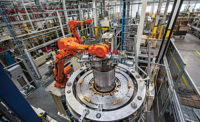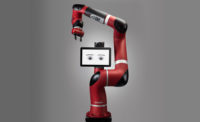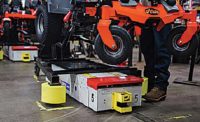Like all manufacturers, fabricators know that they must change when the marketplace requires it. Some of them even welcome the chance to do different things, or at least do them differently. One such fabricator is Last Arrow Manufacturing (LAM), based in Orrville, OH.
For more than a decade, LAM only offered manual welding as a complement to its core competencies of CNC machining, laser cutting and metal forming. That all changed last year when president and co-founder Matt Bowling realized that the company needed an automated welding robot to handle simple and repetitive tasks, so its skilled welders were available to tackle jobs that required more expertise.
“We don’t make high-production parts, so there’s constant changeover in our business,” explains Bowling. “Therefore, we needed [a welding robot with] flexibility.”
After trying various automation options, Bowling met with Brian Sullivan, district sales manager at Lincoln Electric Co. Lincoln is LAM’s welding equipment supplier and a FANUC robot distributor. Sullivan showed Bowling the CRX10iA cobot in action, and Bowling was immediately impressed with its user-friendly appearance, simple operation and iPad-type teach pendant. LAM purchased two cobots shortly thereafter. “
With these cobots, you don’t have to fully automate 100 percent of your production process,” notes Bowling. “We have them weld the subcomponents, so our welders can [focus on] what they’re really good at: fitting and putting products together.”
The dual benefits of this arrangement, according to Bowling, are shorter weldment times and higher production. He cites the example of one weldment that used to take 2 hours to build, but now requires only 17 minutes. As for production, Bowling says the company can now produce 20 finished units in the same time that it used to take to build 12.
“When needed, the CRX cobot can be mounted on a Lincoln Electric Power Wave cart so workers can move it from place to place within the shop,” notes Sullivan. “This allows them to bring the robot to the work instead of bringing the work to the robot.
“One of the big problems with any robot is teaching someone how to use it,” Sullivan continues. “But, you can learn how to program the CRX10iA within a couple hours. This cobot [increases project] opportunities for all fabricators, large and small.”
Scott Musser is the lead robot programmer at LAM, with more than 20 years of experience. He claims that the FANUC cobot is the easiest robot he’s ever had to program, adding that its teach pendant with touch-control icons is the most user friendly.
Over the past year, LAM has seen significant business growth and higher profits—enabling it to purchase two additional CRX10iA cobots. Work scheduling has also improved, along with employee satisfaction.
“The cobots offered [us] a low-cost easy way to [implement] entry-level automated welding,” concludes Bowling. “We are getting into many new market sectors and this gives us better diversity. Plus, we feel that now we’re a manufacturing partner to businesses, rather than just a company that takes bids and does work.”
Introduced in late 2019, the CRX-10iA has a 10-kilogram payload with a 1,249-millimeter reach. A long-arm version, the CRX-10iA/L, has a reach of 1,418 millimeters. Both models safely work alongside people in various industrial and manufacturing jobs.
For more information on cobots, call 888-326-8287 or visit www.fanucamerica.com.





